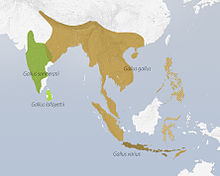| Red junglefowl | |
|---|---|

| |
| Male red junglefowl | |
| Scientific classification | |
| Domain: | Eukaryota |
| Kingdom: | Animalia |
| Phylum: | Chordata |
| Class: | Aves |
| Order: | Galliformes |
| Family: | Phasianidae |
| Genus: | Gallus |
| Species: | G. gallus
|
| Binomial name | |
| Gallus gallus | |

| |
| Red junglefowl (Brown) | |
| Synonyms | |
|
Phasianus gallus Linnaeus, 1758 | |
The red junglefowl (Gallus gallus), also known as the Indian red junglefowl (and formerly the bankiva or bankiva-fowl), is a species of tropical, predominantly terrestrial bird in the fowl and pheasant family, Phasianidae, found across much of Southeast and parts of South Asia. The red junglefowl was the primary species to give rise to today's many breeds of domesticated chicken (G. g. domesticus); additionally, the related grey junglefowl (G. sonneratii), Sri Lankan junglefowl (G. lafayettii) and the Javanese green junglefowl (G. varius) have also contributed genetic material to the gene pool of the modern chicken.[2][3]
Molecular evidence, derived from whole-genome sequencing, has revealed that the chicken was first domesticated from red junglefowl ca. 8,000 years ago,[2] with this domestication-event involving multiple maternal origins.[2][4] Since then, the domestic form has spread around the world, and they are bred by humans in their millions for meat, eggs, colourful plumage and companionship.[5] Outside of their native range, mainly in the Americas and Europe, the wild form of Gallus gallus is sometimes used in zoos, parks or botanical gardens as a free-ranging form of beneficial "pest control", similarly to—and often kept with—the Indian blue peafowl (Pavo cristatus) or the helmeted guineafowl (Numida meleagris); hybridisation has been documented between Gallus and Numida.[6]
- ^ BirdLife International (2016). "Gallus gallus". IUCN Red List of Threatened Species. 2016: e.T22679199A92806965. doi:10.2305/IUCN.UK.2016-3.RLTS.T22679199A92806965.en. Retrieved 19 November 2021.
- ^ a b c Lawal, R.A.; et al. (2020). "The wild species genome ancestry of domestic chickens". BMC Biology. 18 (13): 13. doi:10.1186/s12915-020-0738-1. PMC 7014787. PMID 32050971.
- ^ Eriksson, Jonas; Larson, Greger; Gunnarsson, Ulrika; Bed'hom, Bertrand; Tixier-Boichard, Michele; Strömstedt, Lina; Wright, Dominic; Jungerius, Annemieke; et al. (23 January 2008), "Identification of the Yellow Skin Gene Reveals a Hybrid Origin of the Domestic Chicken", PLOS Genetics, 4 (2): e10, doi:10.1371/journal.pgen.1000010, PMC 2265484, PMID 18454198
- ^ Liu, Y-P.; et al. (2006). "Multiple Maternal Origins of Chickens: Out of the Asian Jungles". Mol Phylogenet Evol. 38 (1): 12–9. Bibcode:2006MolPE..38...12L. doi:10.1016/j.ympev.2005.09.014. PMID 16275023.
- ^ Cite error: The named reference
Storeywas invoked but never defined (see the help page). - ^ "Hibrido gallus gallus x numida meleagris, hybrid bird". juanjosemestra1977 (content creator). 14 December 2011.
